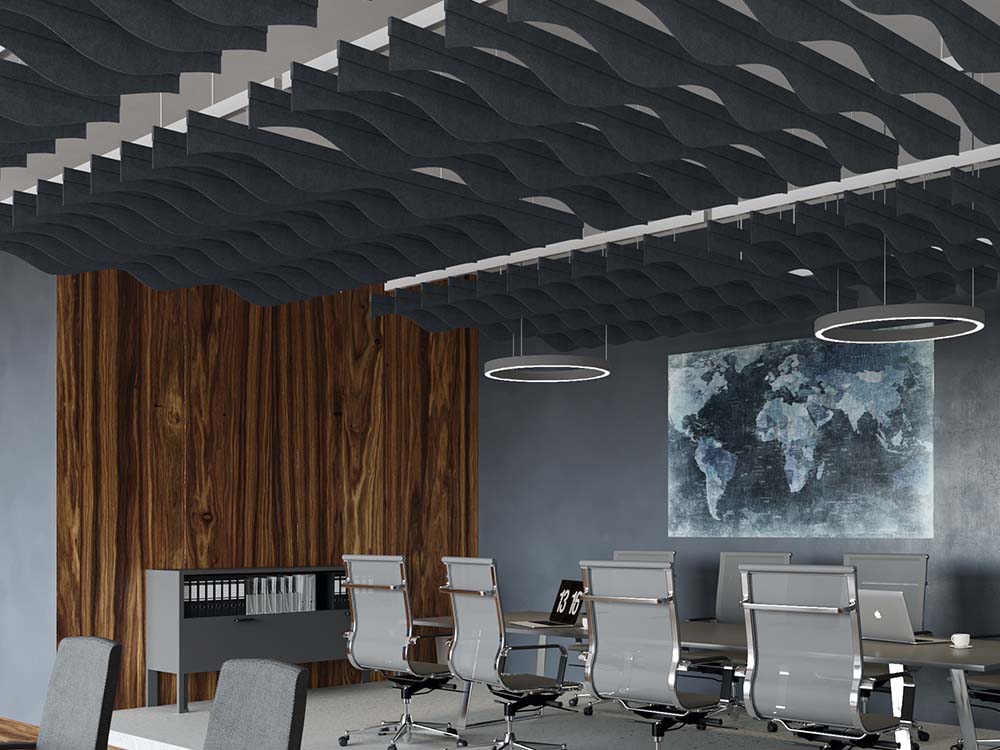BAFFLED?
A LITTLE PRACTICAL INFORMAITON…
Baffles 101... What are they and what do they do?
Baffles are free hanging panels designed to reduce the strength of airborne sound waves by interrupting their flow patterns. They are a fundamental tool used for noise mitigation and are particularly effective in large areas such as pools, auditoriums and renovated industrial type settings such as warehouses that have been redesignated as restaurants or offices.
Vertical baffles...
Baffles which are hung in a vertical fashion provide two surfaces for absorption, capturing sound waves from more than one direction. When installed in sequence they create the illusion of an closed ceiling, but actually allow for air and light movement and an effective sound control solution. They can be wavy, various depths, and hung in grids that travel in more than one direction, depending on the design vision. These lightweight options can be undulating or fixed and create a contemporary finished look.
Horizontal Baffles?
... these are more traditional. You may be familiar wtih simple, flat, rectangular, or geometric panels composed of surface fabric over insulation, and suspended horizontally over head. However they may also be solid in form or grille style panels that are made up of a series of vertical blades or grids.
Fabric "banners" also fall into this category. Banners may span a ceiling area, suspended over cross bars or open trusses to create a billowing or pillowed look. Effective but somewhat less common given todays design trends.
Choosing the right materials
The range of selections are unlimited and there is a fit for every budget and style.
Baffles can be constructed of any acoustically absorbent material. Felt panels have become an industry trend, however there are many options that are equally effective alternatives such as Wood, Wood wool, Insulated "bagged" baffles, and acoustic tubes. They can be painted, or printed, or formed into grilles that create a false ceiling effect while still allowing reflected sound waves to travel through the separations trapping what would otherwise bounce back into the space below.
Placement is relevent to performance
Sounds traveling after the 30 millisecond threshold become the echoes of the original sound. Hard or glossy surfaces create a great trampoline for travelling sound waves.
To best manage this, consider the surfaces that you will most likely need to mitigate. You may wish to add acoustic baffles in these specific areas to interrupt the path of the wave as it reflects. They also disguise mechancial plennums, structural forms, sprinkler systems and industrial type lighting.
Ways to Maximize effectiveness ...
Consider the areas and surfaces (concrete, glass, metal, tile etc) that you will most likely need to mitigate. You may wish to add baffles in these specific areas that will interrupt the course of the sound as it reflects. An acoustic consultant can assist you in mapping these more predictable areas of concern.
Balanced coverage will ensure best results. Square footage of baffles should ideally equal 30 – 60 percent of the ceiling square footage to ensure adequate sound absorption.
Horizontal Wood
Vertical Wave
Vertical Wood Grilles
Flat Horizontal Fabric Panel
Vertical Baffles
Vertical Baffles
Fabric Banners
Explore the range of products available today. Download our corporate brochure!
Sound Advice, Sound Design, Sound Solutions...
Request Information Today
Our team of product experts are available to answer your questions, supply technical data and provide project quotations.
Explore More
